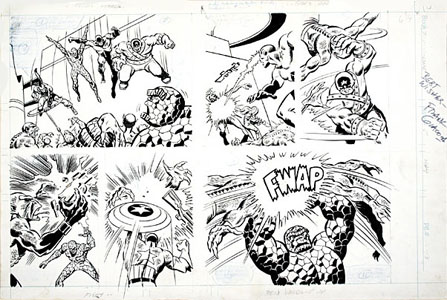I've actually been very busy on this blog today…too busy to write anything to appear here. I've been doing maintenance work including the restoration of hundreds of video links that have become unplayable due to software upgrades. They're not fully restored yet but will be in a week or three. In the meantime, here's a rerun of a piece that ran here on June 3, 2007. I keep getting asked about this…
![]()

This is kind of a "Secrets Behind the Comics." A fellow named Jeff Sharpe sent me the following e-mail with the above illo attached. In case you can't tell what it is, it's a piece of original art from a Marvel comic…except that instead of just drawing a page of comics on the paper, the artist turned it sideways and drew two pages at, of course, a smaller size. Here's what Jeff wrote to me…
I'm in the process of purchasing the above artwork from Marvel Two-In-One and wanted to ask if you had any insight as to why it was drawn this way? Was the entire comic drawn this way, or, just these two pages? If just the two pages, who decided on which pages? I had assumed it would be the center spread, but, that is not the case here. Also, the art is signed by Frank Giacoia, but the comic credits Mike Esposito with the inks. Any info that you could provide would be greatly appreciated!
Here is all the info you need: Around 1974, someone at Marvel came up with one of those ideas that we see so often throughout comic book history — a money-saving idea that doesn't really save any money but at least it inconveniences the creative people and harms the product. It's amazing how often "money-saving ideas" do that.
Budgets were then getting a bit tight. A Marvel comic then had, I think, eighteen pages of story. When the bookkeepers said to look for a way to cut the cost of producing an issue, a plan was devised to pay the artists for drawing seventeen pages but to get eighteen pages of material out of them. The creative folks were instructed that in each issue, they would turn a piece of art board sideways and draw two pages on it…but be paid for one. Usually, it was a double-page spead but sometimes, if story-telling space was too tight to allow for such a spread, it consisted of panels such as the above.
It harmed the quality of the art because two pages didn't have the usual reduction. They were drawn almost printed-size and were therefore less detailed and a bit fuzzy. It also cost money because of added production costs. So that the lettering would be the same size as the rest of the book, the letterer had to letter on another piece of art board and then that lettering had to be statted down to the size of the art and pasted into place. There was also an ethical failing in the whole process. Comic book companies had always taken the position that even if the artist had to draw part of a page on a separate sheet as an overlay, they would count that as one page insofar as pay was concerned because it was one page in the printed comic. Now, the reverse was true…but they still paid for one page. Eventually, after six or eight months, someone realized the whole money-saving move wasn't saving any money and they stopped it.
During the time it was going on, I spent a week hanging around the Marvel offices and I saw how much grief it caused the production people to deal with these sideways pages. At the same time in the Marvel men's room, a sign was posted asking everyone not to waste bathroom supplies. I couldn't resist. I added a little sign that instructed everyone to turn one piece of toilet paper sideways and pretend it was two pieces.
As for the inking credits: During this period, Mike Esposito and Frank Giacoia were running a kind of tag-team inking squadron. They had a number of beginning artists assisting them and they'd ink a whole issue of something in a day or three with everyone pitching in and passing pages around. Some of the jobs were credited to Mike, some to Frank and some to both. When the original art was returned, they just split the inker share without much attention as to who'd inked what. The page looks to me like several folks had a hand in its inking, including both Frank and Mike.